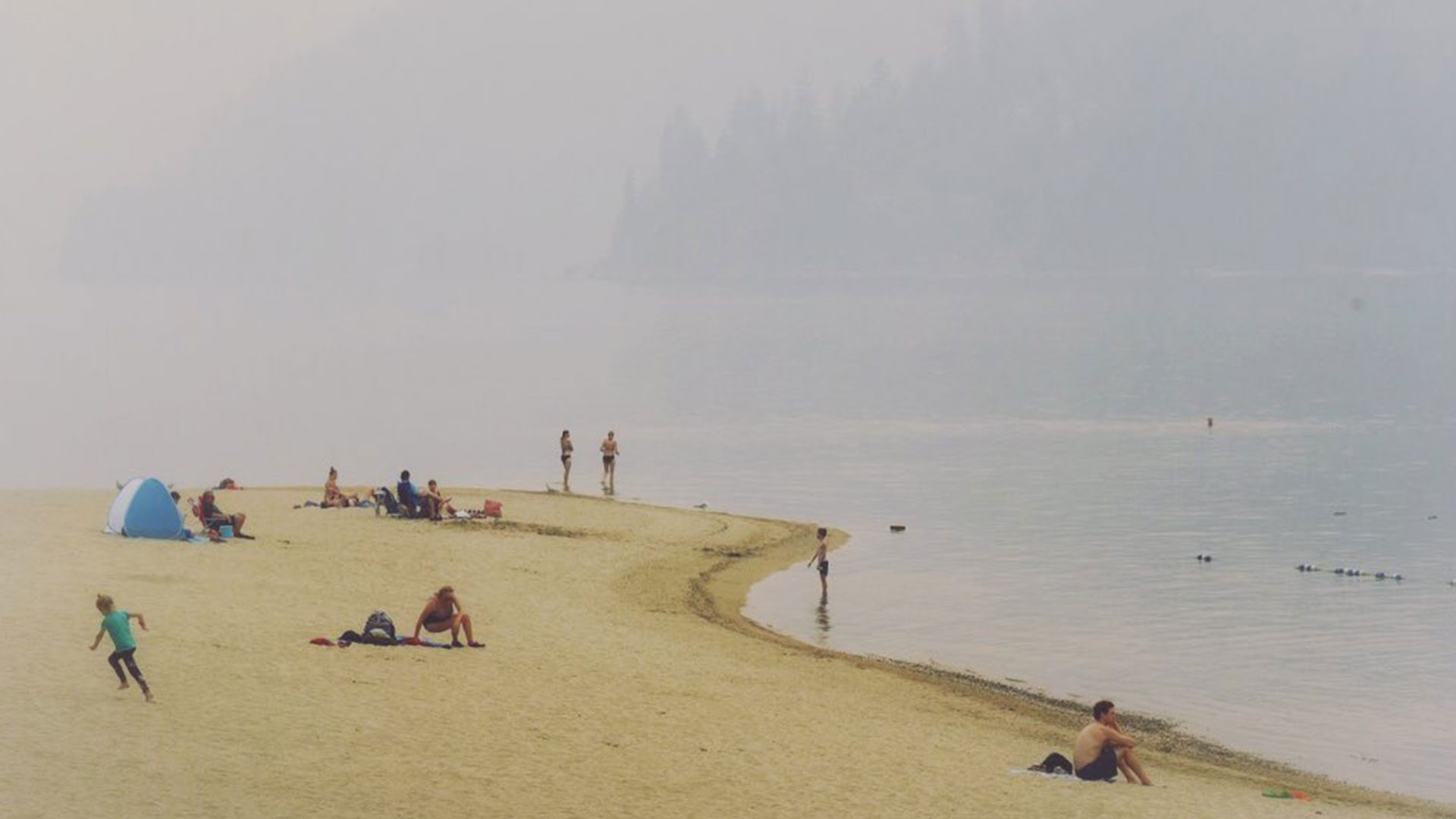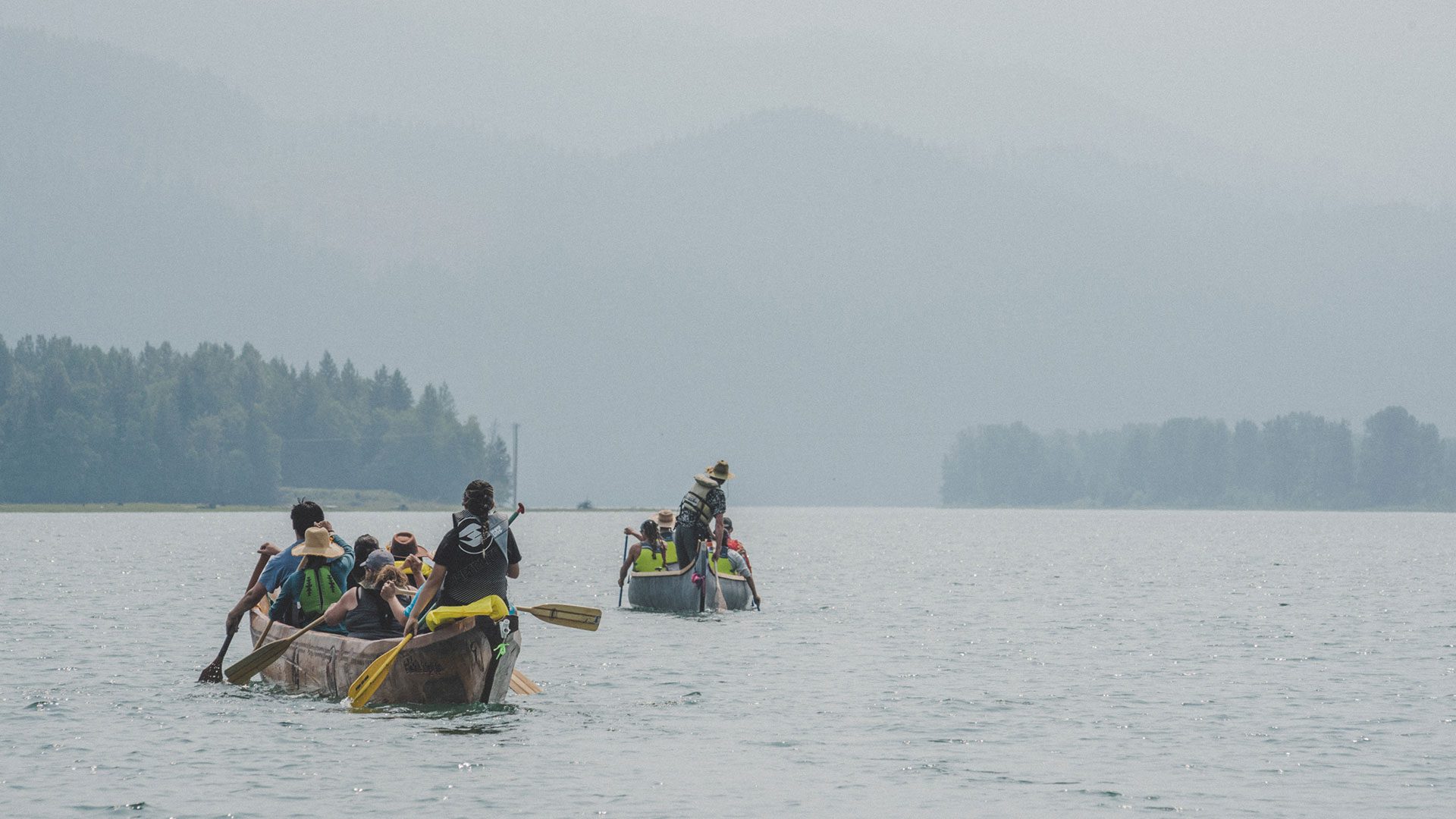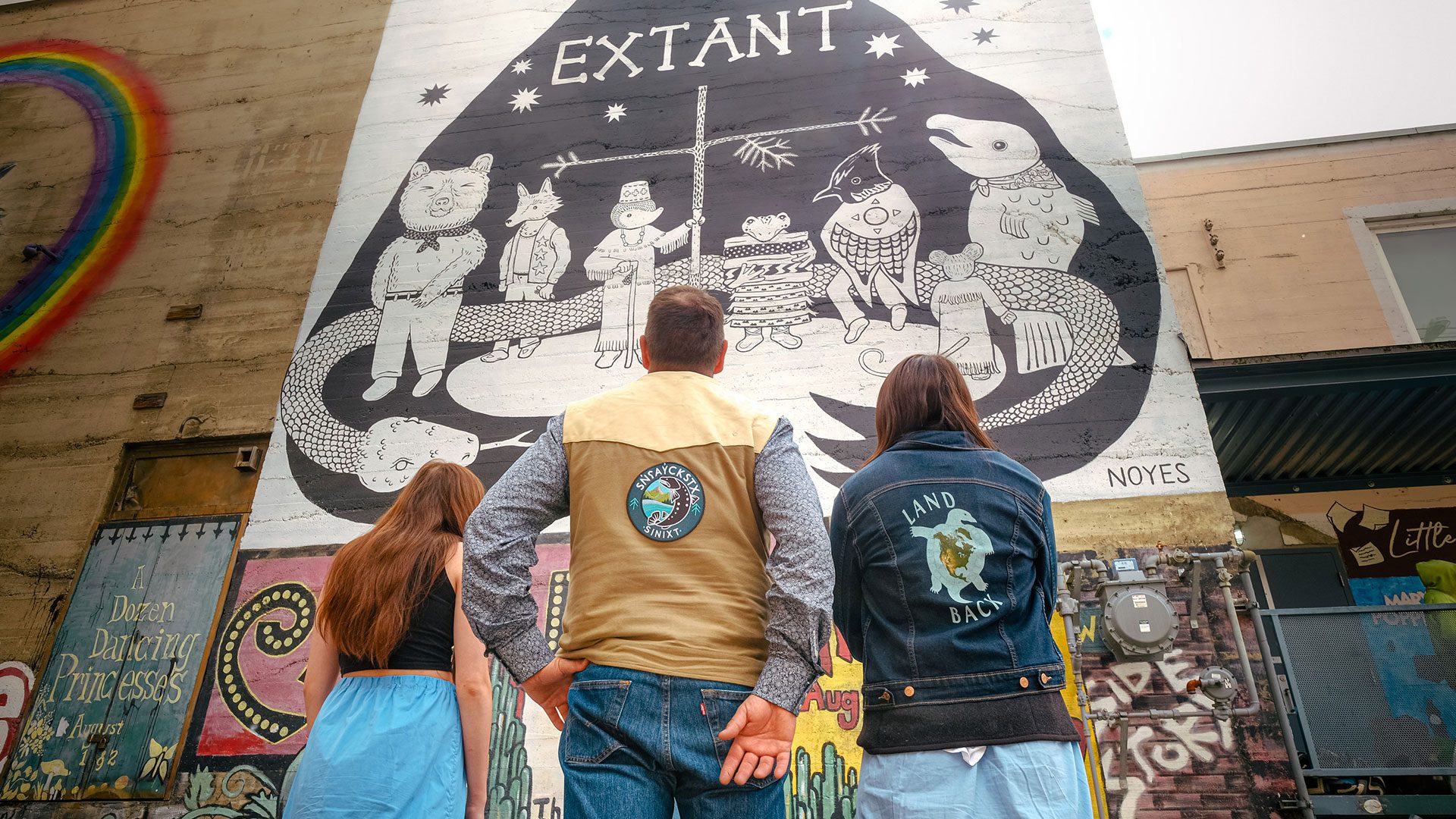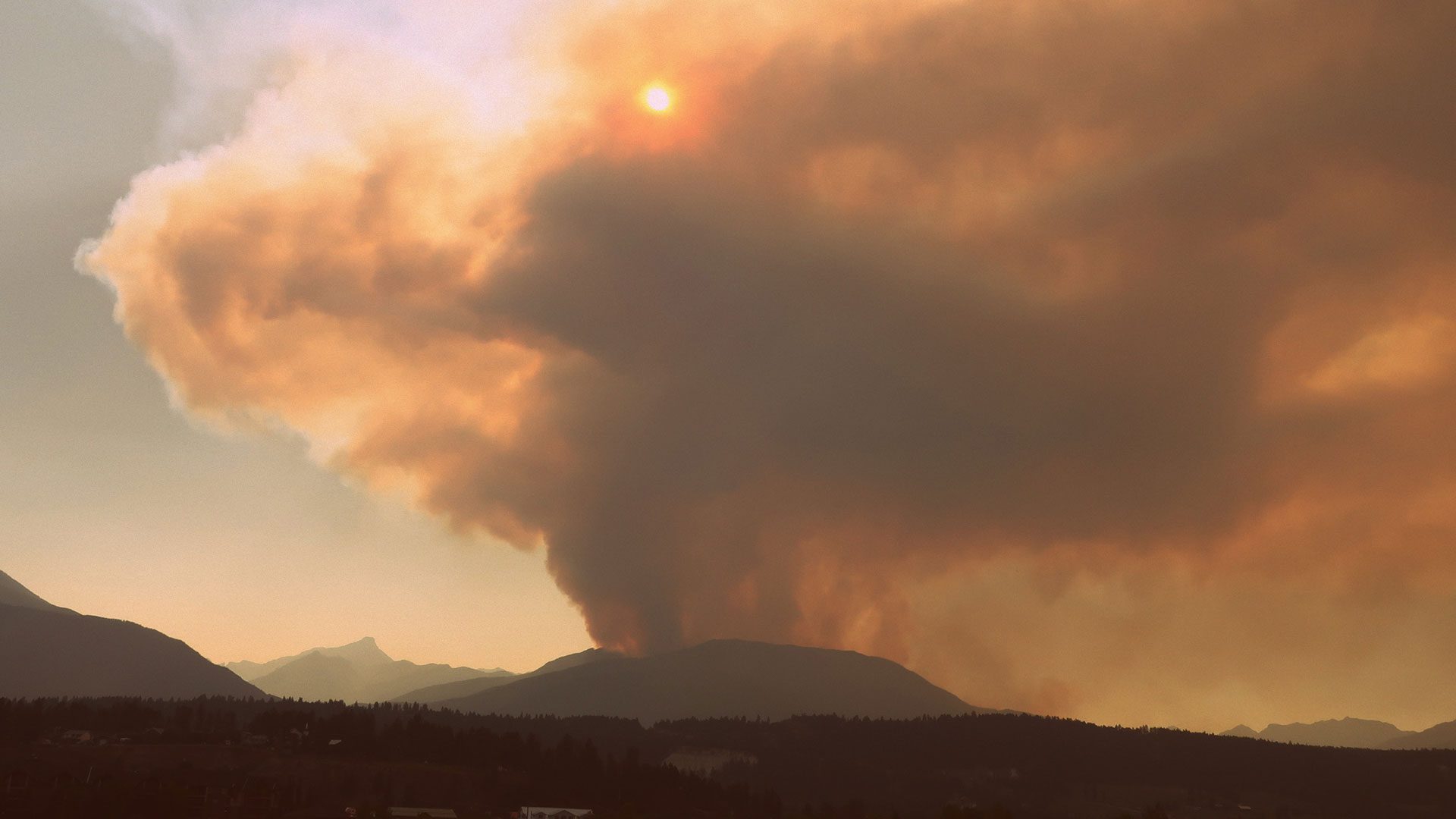
A wildfire sweeps through a mountainside in the Kootenay River watershed in August 2023. Photo by Mike Graeme.
With destructive wildfires impacting communities across Turtle Island, Sinixt knowledge-keepers say policies preventing Indigenous-controlled burns are largely to blame and must be dismantled.
Throughout colonization, European settlers have waged war on fire — and criminalized Indigenous communities who’ve used it for millennia to enhance their lands.
“Fire is not the enemy,” said Janessa Esquivel, a non-binary sn̓ʕaýckstx (Sinixt) and sənpʕʷilx (San Poil) person.
“Fires are part of the ecosystem, of our cultural ecosystems. If Indigenous people were allowed to do what we’ve been doing forever, the fires today wouldn’t look the same.”
The way white settler land management undermined Indigenous systems and suppressed fire has helped lead to the situation today. “Canada” recorded its worst wildfire season on record in 2023, with the amount of scorched land now exceeding 13 million hectares — four times the size of “Vancouver Island” and about twice the previous record.

Sinixt fire expert Cody Desautel, a wildland firefighter for 27 years who now sits on the U.S. National Wildland Fire Management and Mitigation Commission, said Indigenous communities, in general, actually burned more area per year before colonization than the amount burned by megafires, even during this record year.
“Tribes historically burned way more than what we see today,” he said. “There’s research that supports this now, looking at old fire scars and different soil testing.”
The low-intensity Indigenous burns reinvigorated the landscape, helping fire-resilient plants and game animals to thrive, he added.
Uncontrolled megafires can destroy soils, release vast amounts of carbon emissions, and put ecosystems in a state of disrepair. Métis fire scientist Dr. Amy Cardinal Christianson, whose research focuses on Indigenous fire stewardship, said some landscapes can take a century or more to recover from megafires, and in some severe cases they are unable to. Novel conditions of climate change add to the obstacles of forest recovery.
“As you’re coming out of these post-fire events the forest that comes back probably won’t be the forest that was there when it burned,” said Desautel.
On the other hand, cultural burns do not burn as hot and work to clean the forest of debris, often increasing biodiversity and soil health and giving space for culturally important plants that co-evolved with fire.
Desautel also serves as executive director of the Colville Confederated Tribes — a consolidation of 12 Indigenous Nations in the “U.S.” — and has helped bring awareness of Indigenous forest management practices before Congress and into White House staff briefings.
It is the type of fire and their destructiveness that’s different from the past, he said.
The impacts of a catastrophic wildfire on the Colville reservation in 2015 were so bad that the Tribes are in ongoing litigation against the U.S. government over damages they say were due to federal mismanagement.

Laws passed by settler governments, such as B.C.’s Bush Fire Act of 1874, outlawed Indigenous cultural burns. And more than 100 years of fire suppression created “a volatile tinder box of forest fuels across the province” — according to a 2022 report published by the University of Victoria’s Environmental Law Centre — a tinderbox that is becoming increasingly flammable with global heating.
“Without having those regular fire intervals, fuels accumulated on the landscape to levels that were unprecedented in the past,” said Desautel.
Fire suppression and the devaluing of Indigenous knowledge went hand in hand.
“It’s not just with the fire,” said Sinixt hunter Aaron Fitzpatrick. “It’s all these different things. We, the Sinixt, and other tribes, our wisdom and how we took care of the land has been disregarded.”
“If we tried to exercise our management practices or bring attention to them, either our behaviour was immediately criminalized with the case of fire, or it was just disregarded that we didn’t know what we were talking about.”

When European newcomers arrived, they never understood the extent of the complex fire management systems already in place.
“Early settlers experienced a landscape that had between 80 and 95 per cent population reduction of Indigenous people,” said Desautel, referring to how Indigenous communities were devastated by diseases even before settlers physically reached them.
Before their arrival, diseases such as smallpox, measles, and yellow fever did not exist in these regions of the world. Settlers saw the reduced communities as the baseline and used it to justify notions of terra nullius, or “empty land.”
“That’s where you find some of those ideas that you see in the Wilderness Act in the U.S., where they refer to the land as ‘untrammelled by man,’” said Desautel.
Though the Act hopes to “preserve and protect [the land’s] natural conditions,” it claims the land is in its most “natural condition” when there’s an absence of human habitation and influence. And the Act’s so-called “wilderness areas” are places where “the imprint of man’s work is substantially unnoticeable.”
The thousands of years of work by Indigenous Peoples — which helped create these “wilderness areas” — was indeed unnoticeable, if only to settlers.

“I don’t think settlers understood these landscapes were fire-adapted ecosystems and that they didn’t function right without regular fire,” Desautel said.
Waves of displacement
Today, Indigenous communities are disproportionately displaced by catastrophic wildfires. In contrast with non-Indigenous communities, Indigenous ones are 18 times more likely to be evacuated from emergencies, including wildfires and floods.
But displacement is nothing new.
Forced removal to reserves as well as residential or boarding “schools” disrupted cultural practices and knowledge transmission, including fire stewardship.
In the case of the Sinixt, early mining booms pushed many below the border into the “U.S.,” where they were then forced onto the Colville reservation.
In 1956, the Sinixt were declared extinct by the government of “Canada.” This international displacement continues to affect their connection to their homelands.
“A lot of my family can’t even come to this land legally,” said Esquivel. “That border really stops a lot of us crossing. And not even just the people who can’t cross because Canada doesn’t let them cross but [also the people deterred] because there’s a checkpoint and because those people have guns and surveillance.”

Fitzpatrick is one Sinixt person who has found cross-border travel easier following the precedent-setting 2021 supreme court case that recognized Sinixt rights to hunt and fish on their homelands north of the border.
During his hunting trips, Fitzpatrick has found ways to reconnect with fire-altered landscapes.
Last winter, he went to hunt elk in an area burned by fire near kp’ítl’els place of the bitterroot (Castlegar, B.C.). He remembers watching the elk dig at the snow to find the fresh growth from the fire.

“The animals are attracted to the areas where there has been a burn,” he said. “Fire releases the nutrients back into the soil and replenishes it.”
Fitzpatrick’s ancestors culturally burned areas to attract wild game like elk, as well as to replenish huckleberry patches, root gardens, and other foods and medicines. These burns were also conducted ceremonially.

“It saddens me that people haven’t been able to exercise those traditional practices,” Fitzpatrick said. “Now the powers of business and this singular focus on timber has disregarded the health of the forest.”

“We’re making progress, but it’s slow”
The Sinixt Confederacy is set to open its first fish and wildlife office north of the border in October 2023 in ki’yamələp place of dead trees (Nelson, B.C.). Some Sinixt hope it will help with reclaiming stewardship of their lands.

“I am optimistic that we can have a positive impact and that we can bring our histories or centuries of awareness that we have gathered as a community,” said Fitzpatrick.
The Sinixt also bring an awareness of ecosystem conditions that are predicted to migrate north of the border with climate change.
“A lot of what we’ve experienced in Washington State we will probably see in at least southern British Columbia in the next couple decades,” said Desautel.
Sinixt leadership could help increase fire resilience on the land, protect communities, and “put those landscapes on a trajectory to a condition they should be in,” he added.

Revitalizing Sinixt cultural burns north of the border may not be far off. Examples are already taking place across Turtle Island, including neighbouring Ktunaxa territory. This April, the ʔaq̓am community of Ktunaxa Nation and the BC Wildfire Service partnered on a 1,200-hectare cultural burn near “Cranbrook, B.C.”
But the Sinixt still have an uphill battle against a legacy of colonial policies, including their false declaration of extinction.
“We’re making progress, but it’s slow,” said Desautel. “I think [settler governments] recognize the Supreme Court’s decision means things have to change — that we have rights.”
It’s the first time a cross-border Tribe in the “U.S.” has been recognized as having rights in “Canada,” he added.
“The logging industry takes priority”
For millennia, Sinixt have followed laws to ensure the forest remained in a healthy state.
“If you look at what we call our čaptíkʷł — our creation stories — the four-leggeds and the fish came before us, and we have a responsibility to do our part in the ecosystem to make sure that everybody does well,” said Desautel.
“tǝmxʷúlaʔxʷ the land is everything,” said Esquivel. “It’s our mother. It’s also the water, all of our relations, every living thing.”

“All things are interrelated,” said Desautel. “If you take away one thing, it has impacts on all things in the ecosystem. That’s just part of tribal perspectives on management.”
Desautel said this perspective is “unique to what you see in ‘western forestry,’ which was developed in Europe and is largely focused on growth and yield and the economic aspects of forestry and fire.”

Esquivel agreed the economic system imposed on their homelands is at the root of the issue.
“Under capitalism, the logging industry takes priority,” they said. “I learned the phrase ‘merchantable timber’ as a child because that’s how they talk about trees.”
Settler logic dictates that “we have to stop fire because it’s going to burn down the merchantable timber,” they added.
Northern Sinixt homelands are characterized by rare inland temperate rainforest, which is the only of its kind that exists over 400 kilometers from the ocean, according to the Valhalla Wilderness Society.
To maximize merchantable timber production, settler forestry practices have clearcut over 95 per cent of the low-elevation old growth in the inland temperate rainforest region, replanting them with dense stands, which are prone to disease and beetle kill and lack deciduous firebreaks.
Combined with the exclusion of Indigenous fire-related knowledge, beliefs, and practices along with a rapidly warming climate, it’s a recipe for catastrophic fires.

Desautel said he hopes the Sinixt’s work of returning to their homelands north of the border can guide Canada to rethink its “resource-extraction based” model. The megafires ravaging the country are making it more difficult for Canada to turn the other cheek.
“When you look at their fire seasons over the last decade, they’re starting to recognize they may need to do something different,” he said. “They can’t assume those forests will be there to log and serve as a revenue stream for the country.
The urgency of the crisis makes it more pertinent for settler society “to recognize the potential horsepower and value it is to partner with us.”
Story by: Mike Graeme











